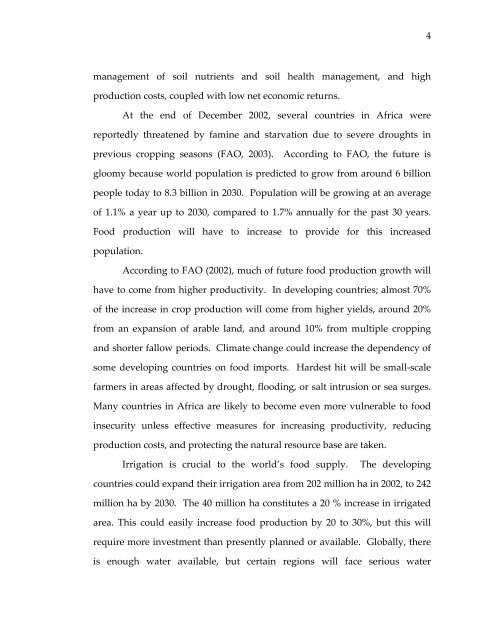Management of rice production systems to increase productivity
Management of rice production systems to increase productivity
Management of rice production systems to increase productivity
Create successful ePaper yourself
Turn your PDF publications into a flip-book with our unique Google optimized e-Paper software.
management <strong>of</strong> soil nutrients and soil health management, and high<br />
<strong>production</strong> costs, coupled with low net economic returns.<br />
At the end <strong>of</strong> December 2002, several countries in Africa were<br />
reportedly threatened by famine and starvation due <strong>to</strong> severe droughts in<br />
previous cropping seasons (FAO, 2003). According <strong>to</strong> FAO, the future is<br />
gloomy because world population is predicted <strong>to</strong> grow from around 6 billion<br />
people <strong>to</strong>day <strong>to</strong> 8.3 billion in 2030. Population will be growing at an average<br />
<strong>of</strong> 1.1% a year up <strong>to</strong> 2030, compared <strong>to</strong> 1.7% annually for the past 30 years.<br />
Food <strong>production</strong> will have <strong>to</strong> <strong>increase</strong> <strong>to</strong> provide for this <strong>increase</strong>d<br />
population.<br />
According <strong>to</strong> FAO (2002), much <strong>of</strong> future food <strong>production</strong> growth will<br />
have <strong>to</strong> come from higher <strong>productivity</strong>. In developing countries; almost 70%<br />
<strong>of</strong> the <strong>increase</strong> in crop <strong>production</strong> will come from higher yields, around 20%<br />
from an expansion <strong>of</strong> arable land, and around 10% from multiple cropping<br />
and shorter fallow periods. Climate change could <strong>increase</strong> the dependency <strong>of</strong><br />
some developing countries on food imports. Hardest hit will be small‐scale<br />
farmers in areas affected by drought, flooding, or salt intrusion or sea surges.<br />
Many countries in Africa are likely <strong>to</strong> become even more vulnerable <strong>to</strong> food<br />
insecurity unless effective measures for increasing <strong>productivity</strong>, reducing<br />
<strong>production</strong> costs, and protecting the natural resource base are taken.<br />
Irrigation is crucial <strong>to</strong> the world’s food supply. The developing<br />
countries could expand their irrigation area from 202 million ha in 2002, <strong>to</strong> 242<br />
million ha by 2030. The 40 million ha constitutes a 20 % <strong>increase</strong> in irrigated<br />
area. This could easily <strong>increase</strong> food <strong>production</strong> by 20 <strong>to</strong> 30%, but this will<br />
require more investment than presently planned or available. Globally, there<br />
is enough water available, but certain regions will face serious water<br />
4
















